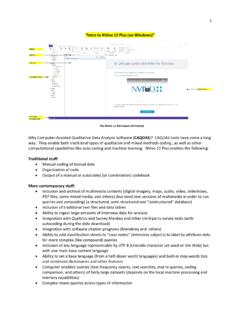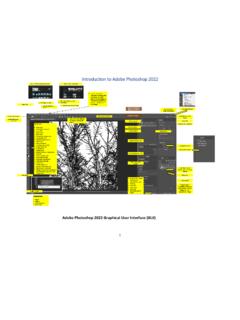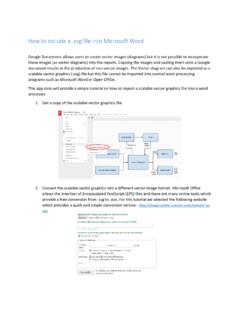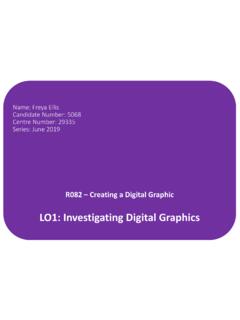Transcription of Introduction to Adobe InDesign (2022)
1 Introduction to Adobe InDesign (2022). 1. Adobe InDesign 2022 is the premiere layout tool for a variety of exports: print publications (paper books, catalogs, posters, brochures, ), digital contents (graphical user Figure 1. A Screenshot of Some Available Templates from Adobe Stock interfaces, digital publications, animations, drawings, (some free, some w/ cost). interactive PDFs ), and others (bus wraps, van decals, billboards ). It has sophisticated layout and image- editing (and image animation) capabilities. InDesign enables high level control of layouts (typography, font), still visuals (imagery), multimedia (art, video, audio, interactivity, animated characters), and other elements. Also, Adobe offers a range of free and paid templates for various file formats (through Adobe Stock). [Read the fine print on the licensure!]
2 Stay legal! Stay legit! There are free templates, too.]. This technology is linked to the Adobe Creative Cloud library objects. It is conceptualized as a design tool to be used in a connected way to the WWW and Internet, so there are sharing capabilities (with built-in critique capabilities), and there are ways to publish to the cloud with randomly-generated links to view and experience the contents. The online versions of publications can feature more interactive contents than the stand-alone interactive PDF. Some newer aspects of Adobe InDesign 2022 (rolled out in October 2021) include the following: automatic inclusion of unique font families in templates that are licensed to the user;. built-in abilities to edit OpenType fonts (such as their line weight, width, and slant, among others);. the use of scalable vector graphics (SVG) or.
3 Svg visuals;. ability to apply column rules in text frames;. ability to use varying page sizes and orientations in one .indd document;. and other advances. Getting started. The Essentials workspace is the simplest (especially for those who get distracted by having too many options available). In-tool creation: You can create contents on-the-fly by starting up InDesign , setting up the parameters of a file, getting your master set up, and creating contents. Building off a template: Or you can open a template and start building from that (and replacing placeholder visuals and text). Artworks, videos, audio, animations, texts, data visualizations : And you can pre-create digital artworks (visuals, video, audio, animations) and texts and place these objects into your file (or you can create the artworks and texts simultaneously to the layout design).
4 There are numerous right ways to start, continue, and complete the work. People all have their own workflows that work for them. General Schedule Hour 1: Introduction to the Adobe InDesign workspaces (and selection of the types). Start screen and workspace Setting up preferences [Edit -> Preferences]. 2. Finding templates online through Adobe Stock (from within the app). Starting a new file (for print, web, mobile, and tablet). Sizing of files [iPad Pro at 2732 x 2048 px; web 1920 at 1920 x 1080 px; letter size x 11 ; artwork; tabloid format for student newspapers, and others]. o The measures are in pixels, points, picas (1/6 of an inch as a typographic unit), inches, millimeters, centimeters, ciceros, agates, and pixels (to enable precision and familiarity based on your preferences). Setting up the master file [purpose of a master, recurring objects, pagination, A-master, blank, B-master] [Type - > Insert Special Character -> Markers -> Current Page Number] [Ctrl + shift + click to unlock text frames made in the master].
5 O Go to the Pages panel to the right. Expand to view the A-Master. To avoid using the styles in the master, highlight a page and click on the [None] to remove the formatting for that page (or sequence of pages). Using layout grids, using pull-out guides 3. Using the frame tool (as placeholders): rectangle, ellipse, polygon (and free-form shaping); fitting images in different ways (to the frame with a right-click on the image, dragged within the frame using the direct select tool, and others). Placing content (File -> Place; Drag and Drop; placing with the placement gun; moving with the content grabber; fitting visual content to frame; using auto text-flow among linked frames OR using the placement gun to drop in other locales). Imagery (every digital type possible except .raw) and video o Anchoring an object frame in a location in a text frame through inline placement (to move with the text even with variant and reflowable output).
6 Can have an object anchored now outside a text (so it is not dependent on the spatial relationship to the text);. can use the blue handle to anchor object outside of the text and in the columnar whitespace [Object ->. Anchored Object -> Options]. o Image frames: handles to scale, blue box for inline graphic, yellow box to activate live corners (shift key and can edit corner separate from other three corners). o AI (artificial intelligence) and content-aware fit Text (serif and sans serif font families). o Overset text and flowing text across frames o Text sizing (ctrl + shift + >; ctrl + shift + <). o Text wrapping o Viewing linked text frames [View -> Extras -> Show Text Threads]. Locking and unlocking items Properties panels (context-sensitive to the activated object). Using rules (for layout and positioning).
7 Aligning multiple objects Setting up smart objects (and their capabilities in the object panels). User-based libraries across Adobe Creative Cloud applications 4. Hour 2: Figure 2. An Image of Footprints . Optional Topics as Time Allows: Easter Egg in the Path Tool Layers and how these generally work Special effects (fx) related to imagery o Object-based stylesheet to apply styles to other objects o fx drag and droppable o Window -> effects o Tinting a grayscale image o Eyedroppers to copy effects (beyond just grabbing colors). Gridifying an image (using a masking approach). o Paste an image in a frame o Select a shape. o Draw the shape over the image. o While holding down the left mouse button, use the (up arrow key) or the (down arrow key) to define the numbers of rows or columns in the grid. o Object Path -> Make Compound Path -> CTRL + Alt + V.
8 O Ctrl + x to hide object (photo in background) (Try this video, too.). Using clipping masks o [Create outlines (CTRL + shift + O)] or [Type Menu -> Create Outlines]. o Paths / held together as compound paths; can break apart by releasing o Applying effects to the respective visual (masks about showing and hiding). o Can use words and shapes and such as custom frames (and showing portions of an image in the background). Outputting book (created from Workspace -> Book). Customized stylesheets to enable changes throughout similar objects with one change (cells, character, object, paragraph, table) [Window -> Styles]; nested styles Fillable PDF forms [Window -> Interactive -> Buttons & Forms, enabling text fields on click]. Defining the Color Space (CMYK, RGB). o Color theme tool / image color swatching o Eyedropper tool Preflight (test) of project file (.)
9 Indd) and proofing a document for output (and link checks) (Tip: Do not change the names of your images or their locations in respective folders. If sharing an InDesign project with others, send the whole zipped folder of everything in order so that the connections hold and the quality of the editable project document is preserved.). 5. o A less formal test involves selecting all and making sure that there are not stray objects on the artboard or the pasteboard (off to the side) although these latter draft / work objects do not usually export out Publishing online (html5). o Page transitions Social sharing for review in-tool History of document (CTRL + About InDesign ). 6. What does a general work pipeline look like with InDesign ? 7. There are many other ways to work and other work pipelines, though, and some start from InDesign and create from there.
10 What works for you is the right way / are the right ways. InDesign as Part of a Work Path: It is helpful to think of Adobe InDesign as part of a work path. As such, it can take as imports various digital and digitized files and can then export the layouts into various formats. Please see the table below. Importable Files (for Placement) Exportable Files Place As Export As Save As / Save a Copy .indd (project file). Online HTML5 files About learning InDesign The digital workspace has various nuances and complexities. The best way I can think of in learning in this space is to learn the basics and then acquire the learning piece-by-piece through watching videos, reading, and trying new things. This is a very safe space to explore (at least outside of actual projects). It helps immensely to use actual low-risk projects for learning, too.








